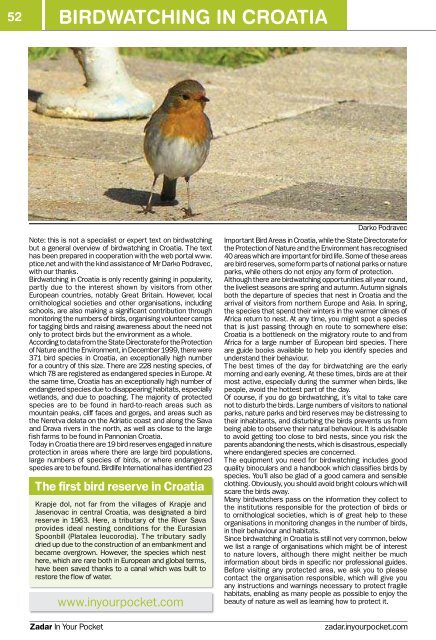Create successful ePaper yourself
Turn your PDF publications into a flip-book with our unique Google optimized e-Paper software.
52<br />
birdwatching in croatia<br />
birdwatching in croatia 53<br />
Note: this is not a specialist or expert text on birdwatching<br />
but a general overview of birdwatching in Croatia. The text<br />
has been prepared in cooperation with the web portal www.<br />
ptice.net and with the kind assistance of Mr Darko Podravec,<br />
with our thanks.<br />
Birdwatching in Croatia is only recently gaining in popularity,<br />
partly due <strong>to</strong> the interest shown by visi<strong>to</strong>rs from other<br />
European countries, notably Great Britain. However, local<br />
ornithological societies and other organisations, including<br />
schools, are also making a significant contribution through<br />
moni<strong>to</strong>ring the numbers of birds, organising volunteer camps<br />
for tagging birds and raising awareness about the need not<br />
only <strong>to</strong> protect birds but the environment as a whole.<br />
According <strong>to</strong> data from the State Direc<strong>to</strong>rate for the Protection<br />
of Nature and the Environment, in December 1999, there were<br />
371 bird species in Croatia, an exceptionally high number<br />
for a country of this size. There are 228 nesting species, of<br />
which 78 are registered as endangered species in Europe. At<br />
the same time, Croatia has an exceptionally high number of<br />
endangered species due <strong>to</strong> disappearing habitats, especially<br />
wetlands, and due <strong>to</strong> poaching. The majority of protected<br />
species are <strong>to</strong> be found in hard-<strong>to</strong>-reach areas such as<br />
mountain peaks, cliff faces and gorges, and areas such as<br />
the Neretva delata on the Adriatic coast and along the Sava<br />
and Drava rivers in the north, as well as close <strong>to</strong> the large<br />
fish farms <strong>to</strong> be found in Pannonian Croatia.<br />
Today in Croatia there are 19 bird reserves engaged in <strong>nature</strong><br />
protection in areas where there are large bird populations,<br />
large numbers of species of birds, or where endangered<br />
species are <strong>to</strong> be found. Birdlife International has identified 23<br />
The first bird reserve in Croatia<br />
Krapje đol, not far from the villages of Krapje and<br />
Jasenovac in central Croatia, was designated a bird<br />
reserve in 1963. Here, a tributary of the River Sava<br />
provides ideal nesting conditions for the Eurasian<br />
Spoonbill (Platalea leucorodia). The tributary sadly<br />
dried up due <strong>to</strong> the construction of an embankment and<br />
became overgrown. However, the species which nest<br />
here, which are rare both in European and global terms,<br />
have been saved thanks <strong>to</strong> a canal which was built <strong>to</strong><br />
res<strong>to</strong>re the flow of water.<br />
www.inyourpocket.com<br />
Darko Podravec<br />
Important Bird Areas in Croatia, while the State Direc<strong>to</strong>rate for<br />
the Protection of Nature and the Environment has recognised<br />
40 areas which are important for bird life. Some of these areas<br />
are bird reserves, some form parts of national parks or <strong>nature</strong><br />
parks, while others do not enjoy any form of protection.<br />
Although there are birdwatching opportunities all year round,<br />
the liveliest seasons are spring and autumn. Autumn signals<br />
both the departure of species that nest in Croatia and the<br />
arrival of visi<strong>to</strong>rs from northern Europe and Asia. In spring,<br />
the species that spend their winters in the warmer climes of<br />
Africa return <strong>to</strong> nest. At any time, you might spot a species<br />
that is just passing through en route <strong>to</strong> somewhere else:<br />
Croatia is a bottleneck on the migra<strong>to</strong>ry route <strong>to</strong> and from<br />
Africa for a large number of European bird species. There<br />
are guide books available <strong>to</strong> help you identify species and<br />
understand their behaviour.<br />
The best times of the day for birdwatching are the early<br />
morning and early evening. At these times, birds are at their<br />
most active, especially during the summer when birds, like<br />
people, avoid the hottest part of the day.<br />
Of course, if you do go birdwatching, it’s vital <strong>to</strong> take care<br />
not <strong>to</strong> disturb the birds. Large numbers of visi<strong>to</strong>rs <strong>to</strong> national<br />
parks, <strong>nature</strong> parks and bird reserves may be distressing <strong>to</strong><br />
their inhabitants, and disturbing the birds prevents us from<br />
being able <strong>to</strong> observe their natural behaviour. It is advisable<br />
<strong>to</strong> avoid getting <strong>to</strong>o close <strong>to</strong> bird nests, since you risk the<br />
parents abandoning the nests, which is disastrous, especially<br />
where endangered species are concerned.<br />
The equipment you need for birdwatching includes good<br />
quality binoculars and a handbook which classifies birds by<br />
species. You’ll also be glad of a good camera and sensible<br />
clothing. Obviously, you should avoid bright colours which will<br />
scare the birds away.<br />
Many birdwatchers pass on the information they collect <strong>to</strong><br />
the institutions responsible for the protection of birds or<br />
<strong>to</strong> ornithological societies, which is of great help <strong>to</strong> these<br />
organisations in moni<strong>to</strong>ring changes in the number of birds,<br />
in their behaviour and habitats.<br />
Since birdwatching in Croatia is still not very common, below<br />
we list a range of organisations which might be of interest<br />
<strong>to</strong> <strong>nature</strong> lovers, although there might neither be much<br />
information about birds in specific nor professional guides.<br />
Before visiting any protected area, we ask you <strong>to</strong> please<br />
contact the organisation responsible, which will give you<br />
any instructions and warnings necessary <strong>to</strong> protect fragile<br />
habitats, enabling as many people as possible <strong>to</strong> enjoy the<br />
beauty of <strong>nature</strong> as well as learning how <strong>to</strong> protect it.<br />
Lake Vrana Nature Park / Lake Vrana Bird Reserve Lake<br />
Vrana lies alongside the coast road between Zadar and<br />
Šibenik, or more precisely, between Pirovac and Pakoštane.<br />
241 bird species have been logged in the area of the Nature<br />
Park, 102 of which nest here. This is a good place <strong>to</strong> spot<br />
the Purple Heron (Ardea purpurea), Great Bittern (Botaurus<br />
stellaris), Corncrake (Crex crex) and Squacco Heron (Ardeola<br />
ralloides), all endangered species in Europe.<br />
The Park staff can organise visits on foot or by boat <strong>to</strong><br />
birdwatching sites upon request. The price of a visit, complete<br />
with an expert guide, is 100kn/h per person, and the trip can<br />
take up <strong>to</strong> five hours. Entry tickets <strong>to</strong> the Nature Park are also<br />
payable (20kn adults, children 7 - 18, 10kn). Visi<strong>to</strong>rs should<br />
bring their own birdwatching equipment, and call ahead <strong>to</strong><br />
announce group visits.<br />
Lake Vrana Nature Park Kralja Petra Svačića 2, Biograd,<br />
tel. (+385-23) 38 31 81, 38 64 52, pp-vransko-jezero@<br />
zd.t-com,www.vransko-jezero.hr.<br />
Pag island The island of Pag is home <strong>to</strong> the following bird<br />
reserves: Kolansko bla<strong>to</strong>, Bla<strong>to</strong> Rogoza, Veliko bla<strong>to</strong> and<br />
Malo bla<strong>to</strong>. All of these are marshlands which are home <strong>to</strong><br />
species including the Gadwall (Anas strepera), Montagu’s<br />
Harrier (Circus pygargus) and Calandra Lark (Melanocorypha<br />
calandra), which are endangered in Europe. Call in<strong>to</strong> the Tourist<br />
Association in Povljana <strong>to</strong> buy entry tickets for the Veliko bla<strong>to</strong><br />
reserve, which has a hide with a checklist.<br />
Povljana Tourist Association Stjepana Radića 20,<br />
Povljana, tel. (+385-23) 69 20 03, (+385)098 184 21<br />
29, tz-povljana@zd.t-com.hr, www.tz-povljana.hr.<br />
Kolan Tourist Association Trg kralja Tomislava, Kolan, tel.<br />
(+385-23) 69 82 90, info@tzkolan-mandre.com, www.<br />
tzkolan-mandre.com.<br />
Telašćica Nature Park This fantastic <strong>nature</strong> park in the<br />
Telašćica Bay on Dugi O<strong>to</strong>k is also designated an Important<br />
Bird Area. 110 bird species have been sighted here. Perhaps<br />
the most exciting birds <strong>to</strong> spot are birds of prey such as the<br />
Peregrine Falcon (Falco peregrinus). The Park is accessible<br />
by boats laid on by travel agencies and private boat owners,<br />
or from dry land from the <strong>to</strong>wn of Sali. Entry tickets cost<br />
28 - 60kn. If you require a guide, please phone one week<br />
in advance.<br />
Telašćica Nature Park Ulica Danijela Grbin bb, Sali, tel.<br />
(+385-23)37 70 96, 37 73 95, telascica@zd.t-com.hr,<br />
www.telascica.hr.<br />
Kornati National Park A national park made up of some<br />
90 islands, islets and reefs spanning the area between<br />
Biograd and Šibenik. The land is owned by the residents<br />
Fun for the whole family<br />
zadar.inyourpocket.com<br />
of the surrounding islands. This is also an Important Bird<br />
Area, although it’s insufficiently researched with respect <strong>to</strong><br />
fauna and flora so there are no accurate data on numbers of<br />
species. In common with other island habitats, owls, seagulls<br />
and the European Shag (no tittering, you at the back) can<br />
be spotted here. You can visit Kornati if you have your own<br />
boat, or as part of a trip organised by a travel agencies and<br />
private boat owners in the areas of Šibenik, Murter, Zadar,<br />
Biograd and the islands in the Zadar area. Tickets are for<br />
sale in the Park itself and in local travel agencies, and cost<br />
150 - 1500kn depending on the size of the boat. There are<br />
no guided <strong>to</strong>urs.<br />
Waterbird Census<br />
Darko Podravec<br />
Bird lovers can take part in the International Winter<br />
Waterbird Census, organised by Wetlands International<br />
on a global level. Taking place over three weeks at the<br />
beginning of January every year, the census aims <strong>to</strong> collect<br />
information on the ever more endangered bird species<br />
that inhabit marshes and other wetland habitats, as well<br />
as on species that nest in the far northern regions of<br />
Europe and Asia. Read more on www.wetlands.org.<br />
Darko Podravec<br />
Zadar In Your Pocket<br />
zadar.inyourpocket.com<br />
zadar.inyourpocket.com<br />
Summer 2011







